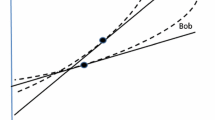Abstract
Afriat’s (Int Econ Rev 14(2): 460–472, 1973) critical cost efficiency index is often used to measure the extent to which experimental choice data violate the axioms of revealed preference. Under certain conditions, the index yields a value of one—which typically signifies rational choice—when, in fact, the choice violates the axioms. We term this a cost efficient violation (CEV) of the axioms, clarify the conditions under which it arises, and find that CEVs comprise the majority of violations in three of four studies reviewed. We suggest changes in experiment design to eliminate or reduce the likelihood of CEVs.




Similar content being viewed by others
Notes
The choices of Andreoni and Miller’s Subject 61 and Subject 90 yield this form of violation (2002, p. 742, Table II).
Six subjects (38, 41, 47, 137, 218, and 221) in Andreoni and Miller’s study report violations consistent with this configuration. Ten subjects (3, 40, 72, 87, 104, 126, 139, 211, 223, and 234) report CEVs that fit a second, similar configuration which arose when the flatter budget line yielded the bundle at the budget line intersection, and the steeper budget line resulted in a bundle lying inside the flatter one.
In both cases, we exclude \(x_1\) from the line segment.
Some studies did not report the order of choice, so while we are able to determine the magnitude of difference between two scenarios, we cannot construct a measure of change based on comparing initial to final relative price.
These violations resulted from subjects facing three more choices than the eight faced by subjects in AM sessions one through four. All five dropped observations (violations) were a subject’s single violation and all were cost efficient ones.
Indeed, because the CCEI is based on the binary comparison of choices, in the case of experiments with three or more goods such as Sippel (1997) study, it is possible that the WARP/WGARP is never violated so that \(e_{ij}=1\) always and hence the CCEI is unity. Yet SARP/GARP could be violated when choices are considered three or more at a time.
References
Afriat, S. N. (1973). On a system of inequalities in demand analysis: An extension of the classical method. International Economic Review, 14(2), 460–472.
Afriat, S. N. (1987). Logic of choice and economic theory. Oxford: Clarendon Press.
Andreoni, J., & Miller, J. (2002). Giving according to GARP: An experimental test of the consistency of preferences for altruism. Econometrica, 70(2), 737–753.
Banerjee, S., & Murphy, J. H. (2006). A simplified test for preference rationality of two-commodity choice. Experimental Economics, 9(1), 67–75.
Banerjee, S., & Murphy, J. H. (2011). Do rational demand functions differ from irrational ones? Evidence from an induced budget experiment. Applied Economics, 43(26), 3863–3882.
Becker, G. S. (1962). Irrational behavior and economic theory. Journal of Political Economy, 70(1), 1–13.
Bronars, S. G. (1987). The power of nonparametric tests of preference maximization. Econometrica, 55(3), 693–698.
Choi, S., Fisman, R., Gale, D., & Kariv, S. (2007). Consistency and heterogeneity of individual behavior under uncertainty. American Economic Review, 97(5), 1921–1938.
Harbaugh, W. T., Krause, K., & Berry, T. R. (2001). GARP for kids: On the development of rational choice behavior. American Economic Review, 91(5), 1539–1545.
Matzkin, R., & Richter, M. (1991). Testing strictly concave rationality. Journal of Economic Theory, 53(2), 287–303.
Rose, H. (1958). Consistency of preference: The two-commodity case. Review of Economic Studies, 25(2), 124–125.
Sippel, R. (1997). An experiment on the pure theory of consumer’s behaviour. The Economic Journal, 107(444), 1431–1444.
Varian, H. R. (1982). The nonparametric approach to demand analysis. Econometrica, 50(4), 945–973.
Acknowledgments
We thank Jordi Brandts, the editors, and two anonymous referees for helpful comments. We also thank Christian Vossler for comments on an earlier draft of this paper and James Andreoni and Jim Miller; Syngjoo Choi, Raymond Fisman, Douglas Gale, and Shachar Kariv; and William Harbaugh, Kate Krause, and Timothy Berry for their data.
Author information
Authors and Affiliations
Corresponding author
Rights and permissions
About this article
Cite this article
Murphy, J.H., Banerjee, S. A caveat for the application of the critical cost efficiency index in induced budget experiments. Exp Econ 18, 356–365 (2015). https://doi.org/10.1007/s10683-014-9407-y
Received:
Revised:
Accepted:
Published:
Issue Date:
DOI: https://doi.org/10.1007/s10683-014-9407-y




